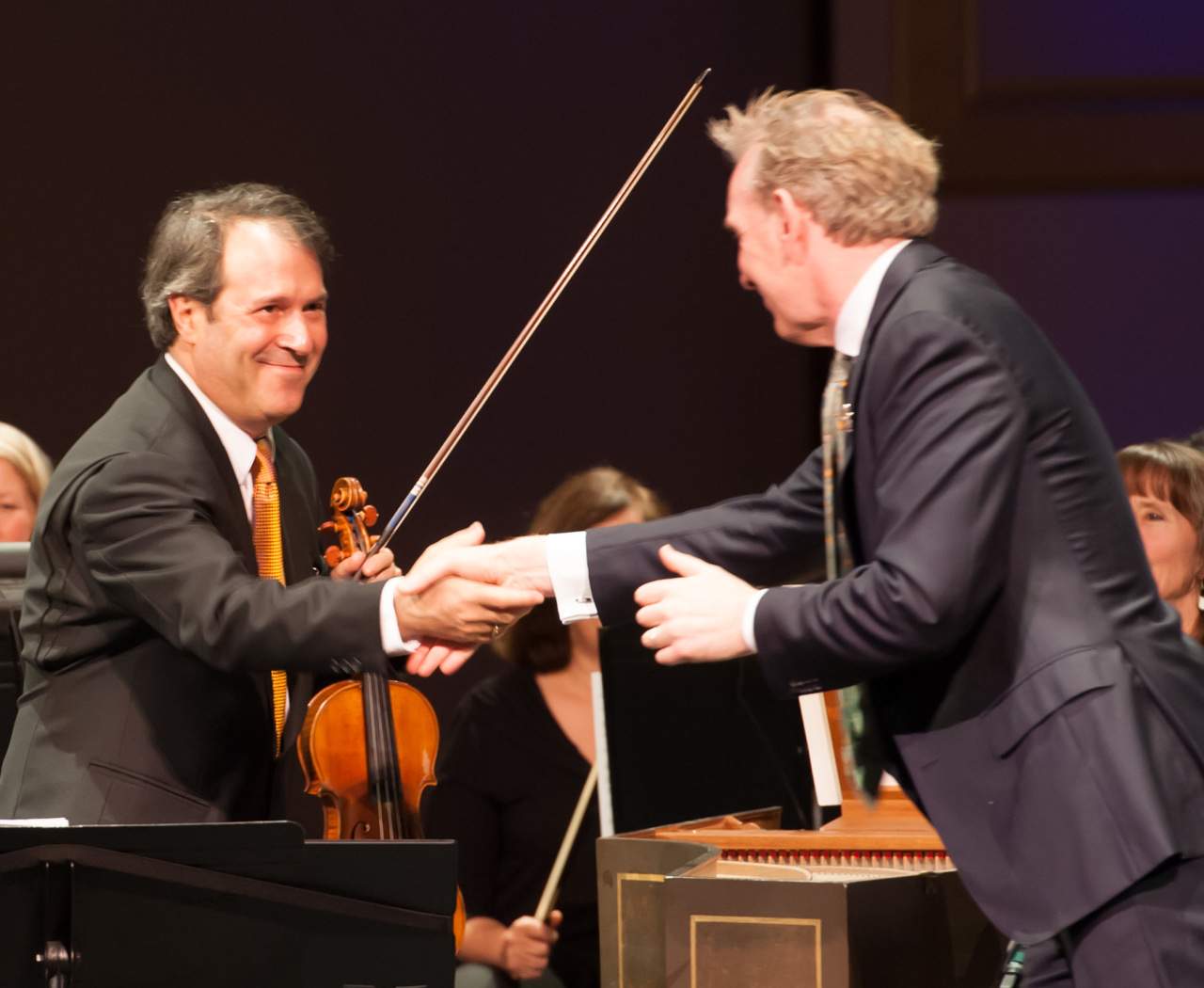The Close of an Era for Marin Symphony
Jeremy Constant and Alasdair Neale. Click for full image. Marin Symphony photo.
ALASDAIR NEALE’S JUBILANT FAREWELL TO MARIN SYMPHONY ORCHESTRA
Alasdair Neale’s final program as director of the Marin Symphony April 22, was, simply put, a triumph. Mr. Neale is leaving after twenty-two years for Paris and the next stage of his career, and he will be sorely missed.
It has been Mr. Neale’s practice to introduce from the stage Symphony programs, and this evening he announced the retirement of two members of the orchestra, cellist Erica Posner and clarinetist Larry Posner. Then he advised the audience to “strap yourselves in” for John Adams’ 1986 Short Ride In a Fast Machine. The four-minute piece opens with a half-note pulse on the wood block and morphs into an electrifying whirl of layered textures. Percussive effects from drum and violins keep the beat while brass and woodwinds take the melodic leads, with joyful filigree work from the flutes and piccolo. The piece was performed with zest and tight discipline.
Jeremy Constant came onstage to perform Mozart’s Violin Concerto No. 5 in A major, K. 219. Tutored in violin by his father, Mozart wrote five violin concertos while still a teenager, no doubt for himself to perform. The nickname for the A Major, Turkish, comes from a Gypsy theme in the final movement that Mozart borrowed from his sketches for the ballet Le gelosie del serraglio (not to be confused with his opera Abduction from the Seraglio). Mr. Constant, performing from score on a Stradivarius given for his lifetime use by the San Francisco Symphony, played with a lithe touch and perfect intonation, backed graciously by a reduced ensemble of some twenty stellar players.
Mr. Constant was Marin Symphony’s concertmaster from 1994 to 2022, and his musical connection with the orchestra and with Mr. Neale created an atmosphere of comfort and intimacy. Tightening his bow for the second and the third movements and playing close to the bridge without harshness, Mr. Constant produced a smooth, silky sound. The concerto flowed gracefully from light to dark to light again. No. 5 is the most innovative of the five violin concertos, with lovely surprises and twists. Its three cadenzas, one in each movement, were written by the virtuoso violinist Joseph Joachim. Rich with complex double-stops and harmonic dissonances, they depart from Mozart’s score yet present a musical continuum, a leap forward in time linking the Classical era to the Romantic era.
For the second half of the program the stage filled almost to bursting with musicians and their instruments, including English horns and a harp, for the final work: Mahler’s monumental Symphony #1 in D major, which Mr. Neale termed “the perfect end to my time here,” explaining that at its ending, "through storm-tossed seas to beautiful harmonies," it concludes triumphantly. He thanked the audience, saying how important it is to support symphony orchestras, “one of humanity’s greatest achievements.”
Mahler began working on his first symphony in 1883-84 while composing his song cycle of heartbreaking love poems, Songs of a Wayfarer. Two of the cycle’s most beautiful themes are expanded in the symphony, and the funeral march in the third movement is similar to the Wayfarer’s final song, “The Two Blue Eyes of my Beloved.” Mahler’s revisions to the symphony were extensive, and he didn’t complete it until 1899, almost 20 years after its inception.
The first movement, Langsam, opened with a long, sustained note in the strings to evoke the breaking of dawn. Trumpets from offstage signaled a radiant awakening studded with birdsong, a celebration of nature that reminded me of Grofé’s tone poem Grand Canyon Suite composed thirty years later. The second movement was a sensual waltz full of slurs and slides by the strings; and the third, the funeral march, which Mahler built on the round “Frère Jacques,” began as a lament and bloomed into a raucous carnival romp. The fourth movement erupted explosively, a wild storm laced with thunder and lightning building to full strength, waning and re-gathering force as it accelerated to a jubilant conclusion.
Nearing the coda I began to grin and couldn’t stop; it was like watching one’s favored thoroughbred when you know he’s going to win the race. When Mr. Neale lowered his baton, the whole audience rose to express delight and appreciation. Mahler, who had struggled mightily to complete and revise his symphony, would have loved it.
Published at classicalsonoma.org on April 28, 2023
